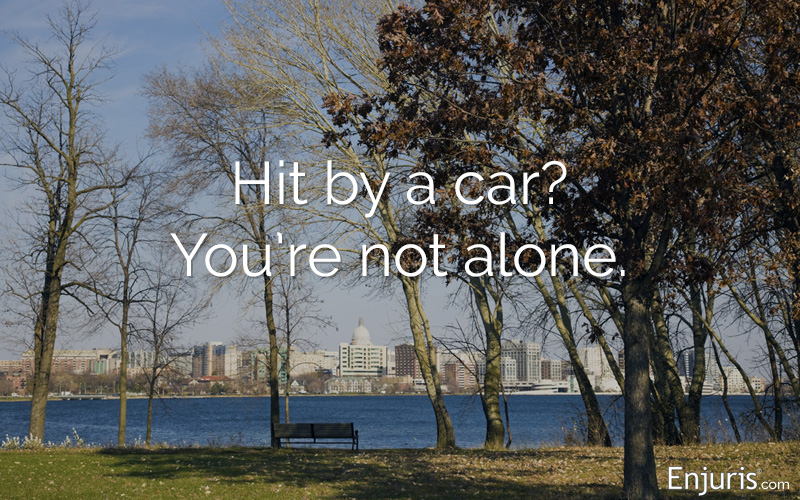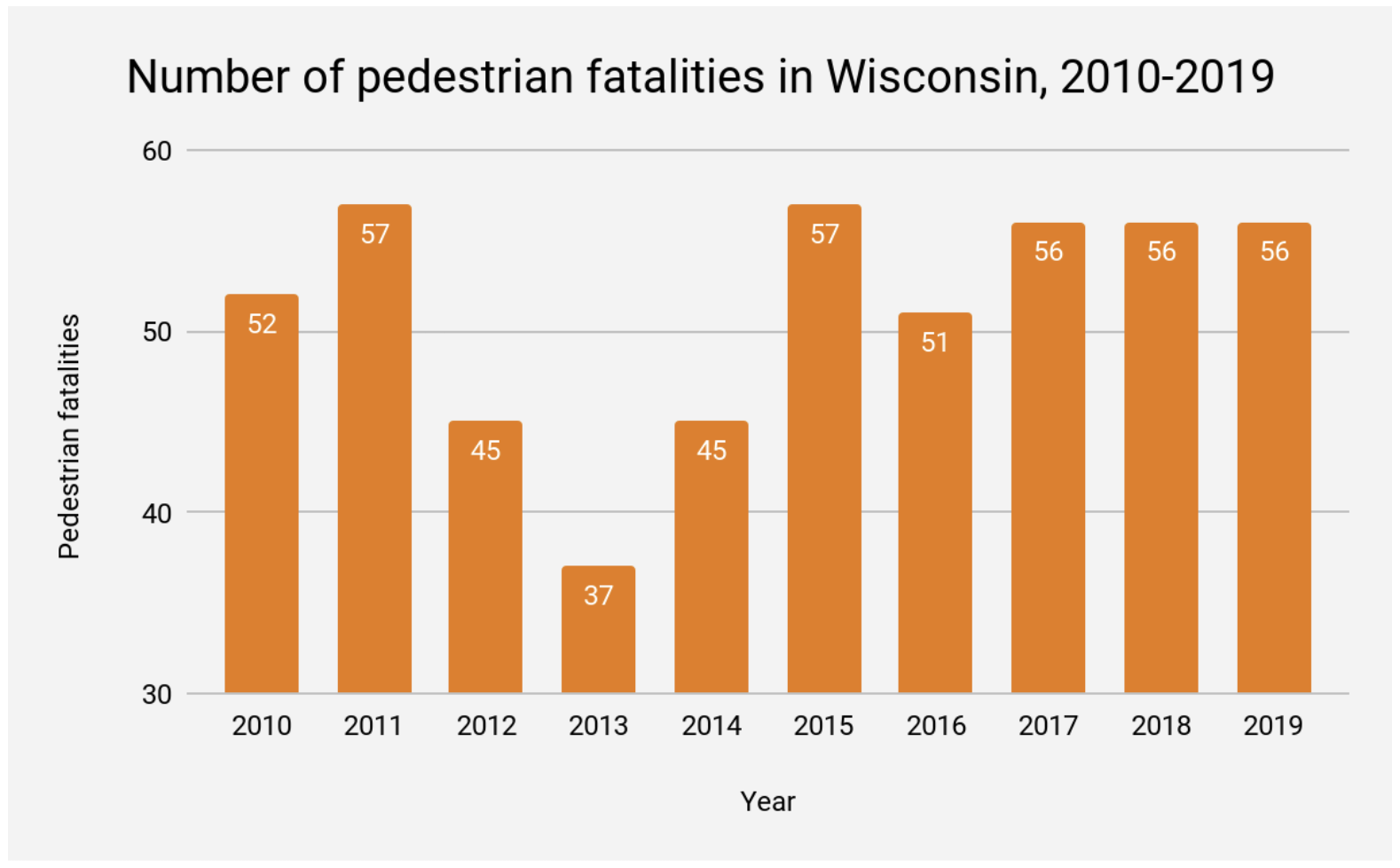
There is compensation available for injured pedestrians, whether it’s a car accident or premises liability claim
Between 2019 and 2020, the number of pedestrians killed nationwide increased 21%. This was despite the fact that there were fewer cars on the road at the beginning of the COVID-19 pandemic, but many drivers began driving recklessly because of the seemingly empty roads.
The Wisconsin Department of Transportation reports around 60 pedestrian deaths each year in the Badger State, with another 350 non-fatal injuries.

Crawford and Burnett counties had the highest numbers of pedestrian fatalities from 2015-2019, each with about 6 per 100,000. They’re followed by Oconto County, with 5 pedestrian fatalities per 100,000 people in that time frame.
Types of pedestrian accidents
There are a number of ways a pedestrian could be injured. The most common is by being hit by a car or injured by a property-related hazard.
A pedestrian, just like a driver, has a right to be compensated if they are injured in an accident that is the result of someone else’s negligence.
That means if someone (a person, company, or entity) was negligent in a way that caused you an injury that resulted in a financial loss to you, you could pursue an insurance claim or lawsuit. How you collect that money depends on who (or what) was negligent, your role in the accident (that is, if you had any liability) and how the accident happened.
Common causes of pedestrian/car accidents include:
- The driver did not stop at a red light or stop sign.
- The driver turned through a crosswalk.
- The driver did not look for pedestrians when backing up.
- The driver was speeding.
- The driver was distracted, either by texting or something else.
Examples of driver negligence
There are lots of ways a driver can be negligent, but here are just a few examples:
- Speeding
- Failing to stop at a traffic light or stop sign
- Failing to give a pedestrian enough room to enter or exit a parked car
- Failing to move over or slow down for a person in the break-down lane
- Texting and driving, or other distracted driving
- Driving under the influence of drugs and alcohol
Pedestrian trip-and-fall accidents
You can also get hurt as a pedestrian even without ever interacting with a car or other moving vehicle.
If you fell or were injured because of a broken sidewalk or stairs, icy or otherwise slippery surface, or some other hazardous condition, your case might fall under premises liability law.
In order to demonstrate negligence in a premises liability claim, you need to prove the following:
- The owner was in control of the property,
- The owner was negligent in maintaining the property in a way that was reasonably free of hazards,
- You were harmed as a result of the owner’s negligence, and
- Your injury costs you money for medical treatment, lost wages, or related expenses directly related to the accident.
If you fell on private property, you’d need to find out who is the owner and who was responsible for maintenance.
It’s worth emphasizing that in order to file a lawsuit for this type of injury (or any type of injury), the injury has to have cost you money. You might be angry or frustrated because you skinned your knee or sprained your ankle from falling on a sidewalk or on the street, but if you did not receive medical treatment, lose time from work, or have other expenses that were a direct result of the injury, you cannot recover damages in a lawsuit.
Wisconsin pedestrian laws
Wisconsin sets forth laws to allow pedestrians and drivers to safely share the road. They include:
| Pedestrian responsibilities | Driver responsibilities |
|---|---|
| Yield to drivers when crossing a road if there is no intersection or crosswalk or if you do not have a green light or walk signal and the driver does. | Yield to pedestrians who are crossing a sidewalk or entering a driveway. |
| Avoid sudden movements into the path of an approaching car that doesn’t have time to yield. | Yield to a pedestrian who has begun to cross at an intersection or crosswalk on a walk signal or green light. Also, yield to a pedestrian crossing within a marked or unmarked crosswalk if there is no traffic light or control signal. |
| Walk along the left side of the road if there is no sidewalk available. | Do not overtake or pass a vehicle that is stopped at an intersection or crosswalk to allow a pedestrian to cross. |
Obtaining compensation after a Wisconsin pedestrian accident
If you’re in an accident involving a trip-and-fall or suffer another premises liability, you would file a claim against the owner of the property. They will usually rely on their homeowner’s or property insurance to cover your losses. But if the insurance policy doesn’t cover the full extent of your expense, then you could file a personal injury lawsuit.
Similarly, if you’re hit by a car, the driver’s insurance should be the first line of defense to recover costs. Wisconsin is an at-fault insurance state, which means even if you have your own auto insurance, the at-fault driver should cover your costs.
As a pedestrian, you might not have auto insurance that covers this type of injury if you don’t own a car. If the driver’s insurance doesn’t cover all of your expenses, or if they are uninsured, you can file a personal injury lawsuit against them.
Wisconsin modified comparative fault rule
Even if you’re hit by a car, you might bear some liability for the accident. For instance, the driver could have been cautious, obeying the speed limit and following traffic signals but you were looking at your phone and walked in front of their car unexpectedly.
Yes, the driver has a duty to pay attention and “expect the unexpected” while behind the wheel, but you also have a duty to walk in a predictable way and pay attention.
Wisconsin’s modified comparative fault rule says that a plaintiff (the injured person) must have no more than 50% of the shared liability for an accident in order to recover damages. If the plaintiff is partially responsible for the accident (or could have avoided it but didn’t), then the amount of money they can recover for their injuries is reduced according to their percentage of fault.
What to do if you’ve been injured in a pedestrian accident
The first step after any accident or injury is always to obtain the medical care you need. If you’re unable to walk or move any part of your body, if you bumped your head, or if you’re dizzy or unsteady, call 911.
Just like in a car accident, you might think you’re unharmed right after the injury happens. But that doesn’t mean symptoms won’t appear later or in the days or weeks ahead. Even if you don’t think you need to call 911 or require emergency medical services, you should still visit your doctor or an urgent care facility to be evaluated and have your physical condition documented.
Likewise, if you’re a witness to a pedestrian accident, make sure that any injured person is receiving the care they need before you leave the scene. If they’re unable to make phone calls on their own, help them if you’re able to do so. Particularly if the injured pedestrian is a child or an older person, ask if they know the phone number of a family member who you can call, and contact that person immediately after you’ve called 911.
If you’ve been in a pedestrian accident and you’re not seriously hurt, try to gather the following information:
- The name and contact information of the driver and any other people involved
- The driver’s license number, insurance information, and the car’s license plate number
- Contact information of any witnesses
- Police report
Even if you think your injuries are minor (or nonexistent), it’s important to get a police report at the scene of any accident involving a motor vehicle. This can go a long way toward preserving your legal rights if you end up needing to file a claim either against the insurance company or as a lawsuit.
Types of damages you can recover after a pedestrian accident
“Damages” refers to the amount of money you can receive after an accident. You are entitled to have the at-fault driver pay for your related expenses, which can include:
- Medical treatment, such as doctor or hospital visits, prescription medication, assistive devices, prosthetics, diagnostic testing (like X-ray, MRI, CT scans), and others
- Ongoing physical or rehabilitative therapies
- Emotional distress or pain and suffering
- Wrongful death (if you’re a family member of someone who was killed in an accident)
- Lost wages during recovery and lost future earning capacity
10 safety tips for pedestrians
- Always cross at a corner or intersection and use a marked crosswalk where available.
- Yield the right-of-way to a vehicle if crossing where there’s not a marked crosswalk.
- Before crossing, look left, then right, then left again to check for cars.
- Walk facing traffic.
- Obey traffic signals and walk signs.
- Be alert — don’t text or be occupied on your phone while walking.
- If you’re wearing a listening device, either keep 1 ear “free” or the volume low enough that you can still hear outside noise like traffic.
- Wear reflective clothing when walking at night and carry a flashlight.
- Avoid walking while intoxicated; impairment can increase your risk of being hit by a car.
- Walk on the sidewalk or designated walking area where one is available. If there isn’t a sidewalk, stay as far to the left as possible.
When to call a personal injury lawyer for your pedestrian accident
It’s never too soon to find a personal injury lawyer after an accident. Especially if your injuries are severe, you might be out of work or require ongoing therapies or treatments, and you want to be sure that your costs will be covered.
Visit the Enjuris Personal Injury Law Firm Directory to find a list of Wisconsin lawyers near you who are ready to help. Hiring an attorney to minimize your liability and negotiate with the insurance company can ensure you get the best possible settlement, and they can guide you through filing a lawsuit if necessary.
See our guide Choosing a personal injury attorney.
